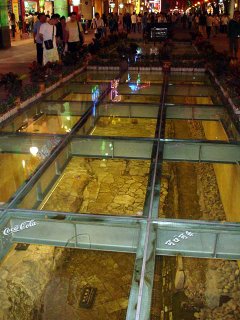 I arrived at the Guangzhou East Train Station at 11 a.m. I was met at the station by Jiajin, our liaison officer during the program who was nice enough to take me around Guangzhou during my last day in China. We hadn't been able to see Guangzhou during the program in Guangdong Province since the activities were in Dongguan City.
I arrived at the Guangzhou East Train Station at 11 a.m. I was met at the station by Jiajin, our liaison officer during the program who was nice enough to take me around Guangzhou during my last day in China. We hadn't been able to see Guangzhou during the program in Guangdong Province since the activities were in Dongguan City.From the Guangzhou East Station, we took a subway to the Guangzhou Train Station (there are two stations in Guangzhou) since the hotel I was going to stay in was right beside it. It was convenient for me since right beside the hotel was the China Southern office and the pick-up point for the airport shuttle which left every 15 minutes. I paid RMB150 for a single room.
We had lunch at the KFC beside the hotel. From there, we took a subway to the Sun Yat-Sen Memorial Hall. The hall is situated on the southern slope of Yuexiu Hill and was constructed between 1929 and 1931 by the people of Guangzhou and overseas Chinese as a monument to Dr. Sun Yat-sen, the forerunner of Chinese democratic revolution.
 Since Jiajin had classes at 3 p.m., we took a 40-minute bus to the Guandong University of Foreign Studies where he is a graduating student. I stayed at his dorm and surfed the Internet while he was in class.
Since Jiajin had classes at 3 p.m., we took a 40-minute bus to the Guandong University of Foreign Studies where he is a graduating student. I stayed at his dorm and surfed the Internet while he was in class.After his class, we took another bus back to the city center. I wanted to pass by a supermarket to check out the local food. We decided to buy dinner there. Got myself some rice noodles and vegetable pie while he got some dumplings. Also bought some dried fruits and my supply of water. From there, we walked towards the Shangxiajiu Walking Street (上下九商业步行街) a famous shopping area of Guangzhou.
What I liked about the place was the glass covered display of an old street which was accidentaly discovered in 2002 during excavations for a redevelopment project. But instead of destroying the old street and other remnants of the city's heritage, like what Mayor Atienza did in Mehan Gardens and Cuartel Meisic, Guangzhou covered it with glass and it is now an attraction of the walking street.
 It was not only one street but actually layer upon layer of streets from various periods dating back to the Tang Dynasty (618 to 907 AD). Between then and the period of the Republic of China (1912 to 1949), ten additional layers were added. The bottom grit layer is about 3 meters below the surface. At a depth of 4.5 meters, the remains of the Southern Yue Kingdom (203 to 211 BC) were found. From 7.9 meters below, the surface lies gray-red virgin soil, which reveals that the site was once a riverbed. If you check out the photo, each label is from a different period of China's history. I hope we are able to find things like these in the Philippines.
It was not only one street but actually layer upon layer of streets from various periods dating back to the Tang Dynasty (618 to 907 AD). Between then and the period of the Republic of China (1912 to 1949), ten additional layers were added. The bottom grit layer is about 3 meters below the surface. At a depth of 4.5 meters, the remains of the Southern Yue Kingdom (203 to 211 BC) were found. From 7.9 meters below, the surface lies gray-red virgin soil, which reveals that the site was once a riverbed. If you check out the photo, each label is from a different period of China's history. I hope we are able to find things like these in the Philippines. After taking some photos, we went back to the hotel to eat our supermarket dinner. Didn't stay up too late since my flight was early in the morning and I had to be up before 6 a.m. to catch the 50-minute shuttle to the airport. My flight back to Manila leaves at 8:45 a.m. Anyway, this is my last post on my China trip. Until the next adventure!
After taking some photos, we went back to the hotel to eat our supermarket dinner. Didn't stay up too late since my flight was early in the morning and I had to be up before 6 a.m. to catch the 50-minute shuttle to the airport. My flight back to Manila leaves at 8:45 a.m. Anyway, this is my last post on my China trip. Until the next adventure!
